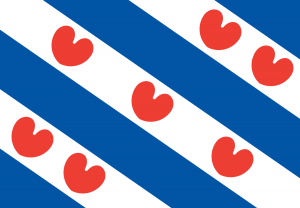Language/Western-frisian/Grammar/Adjectives
Hi Western Frisian learners! 😊
In this lesson, we will learn about adjectives in Western Frisian grammar. Adjectives are words that describe or give more information about a noun. For example, "the big house" - "big" is an adjective that describes the house. Let's dive in and explore more about adjectives in Western Frisian!
Finish this lesson and explore these related pages: Gender, Give your Opinion, Negation & 0 to A1 Course.
Adjective placement[edit | edit source]
In Western Frisian, adjectives usually come before the noun they describe. For example: "in groun auto" (a green car), "in nij boek" (a new book), "in moai blom" (a beautiful flower). However, there are some exceptions to this rule when using certain adjectives in specific situations, which we will explore below.
Predicative adjectives[edit | edit source]
Predicative adjectives are adjectives that come after a linking verb, such as "is," "was," or "becomes." In these cases, the adjective follows the noun they describe. For example: "De blom is moai" (The flower is beautiful), "De auto wie nij" (The car was new), "It bier smakket fris" (The beer tastes fresh).
Attributive adjectives[edit | edit source]
Attributive adjectives are adjectives that come before the noun they describe. There are some cases where the adjectives come before the predicate. For example, when the adjective is used in a comparative or superlative form, such as "better," "best," "worse," "worst." Some examples of proper adjective order in Western Frisian are: "in nijere auto" (a newer car), "in heechste berg" (the highest mountain), "in lyts hûs" (a small house).
Adjective agreement[edit | edit source]
In Western Frisian grammar, adjectives must agree in number and gender with the noun they describe. This means that the adjective must have the same number and gender as the noun. For example: "De nij boeken" (the new books), "De moaie fammen" (the beautiful girls).
Number agreement[edit | edit source]
Number agreement means that the adjective must match the number of the noun. If the noun is singular, the adjective should also be singular. If the noun is plural, the adjective should also be plural. For example: "in groen auto" (a green car) becomes "de groene auto's" (the green cars).
Gender agreement[edit | edit source]
Gender agreement means that the adjective must match the gender of the noun. Western Frisian has two grammatical genders: masculine and feminine. If the noun is masculine, the adjective should be masculine. If the noun is feminine, the adjective should be feminine. For example: "De moaie fammen" (the beautiful girls) - "moaie" is a feminine adjective, matching the feminine noun "fammen".
Here are some examples of adjective agreement:
| Western Frisian | Pronunciation | English |
|---|---|---|
| in nij boek | in nij boek | a new book |
| de nij boeken | de nij boeken | the new books |
| in grut hûs | in grut hûs | a big house |
| de grutte huzen | de grutte huzen | the big houses |
Comparison of adjectives[edit | edit source]
In Western Frisian, adjectives can either be compared by adding -er or by using the adverb "mear" (more) before the adjective. For example: "Heech" (high) becomes "Heecher" (higher), "Moai" (beautiful) becomes "Moaier" (more beautiful). Here are some more examples:
| Western Frisian | Pronunciation | English |
|---|---|---|
| linich | linich | careful |
| liniger | liniger | more careful |
| einliks | einliks | actually |
| einliker | einliker | more actually |
| nij | nij | new |
| nijer | nijer | newer |
Dialogue[edit | edit source]
- Person 1: Dit is in ____ boek (This is a ____ book)
- Person 2: Wat foar boek? (What kind of book?)
- Person 1: In ____ boek. (A ____ book.)
- Person 2: In nij boek? (A new book?)
- Person 1: Ja, in nij boek. (Yes, a new book.)
Conclusion[edit | edit source]
Adjectives are an important part of Western Frisian grammar. Knowing how to properly use adjectives, their placement, and their agreement with gender and number will greatly improve your language skills. To improve your Western Frisian grammar, you can also use the Polyglot Club website. Find native speakers and ask them any questions!
➡ If you have any questions, please ask them in the comments section below.
➡ Feel free to edit this wiki page if you think it can be improved. 😎
Having concluded this lesson, consider checking out these related pages: Say Hello and Greetings in Western Frisian, Plurals & Descriptive Adjectives.

